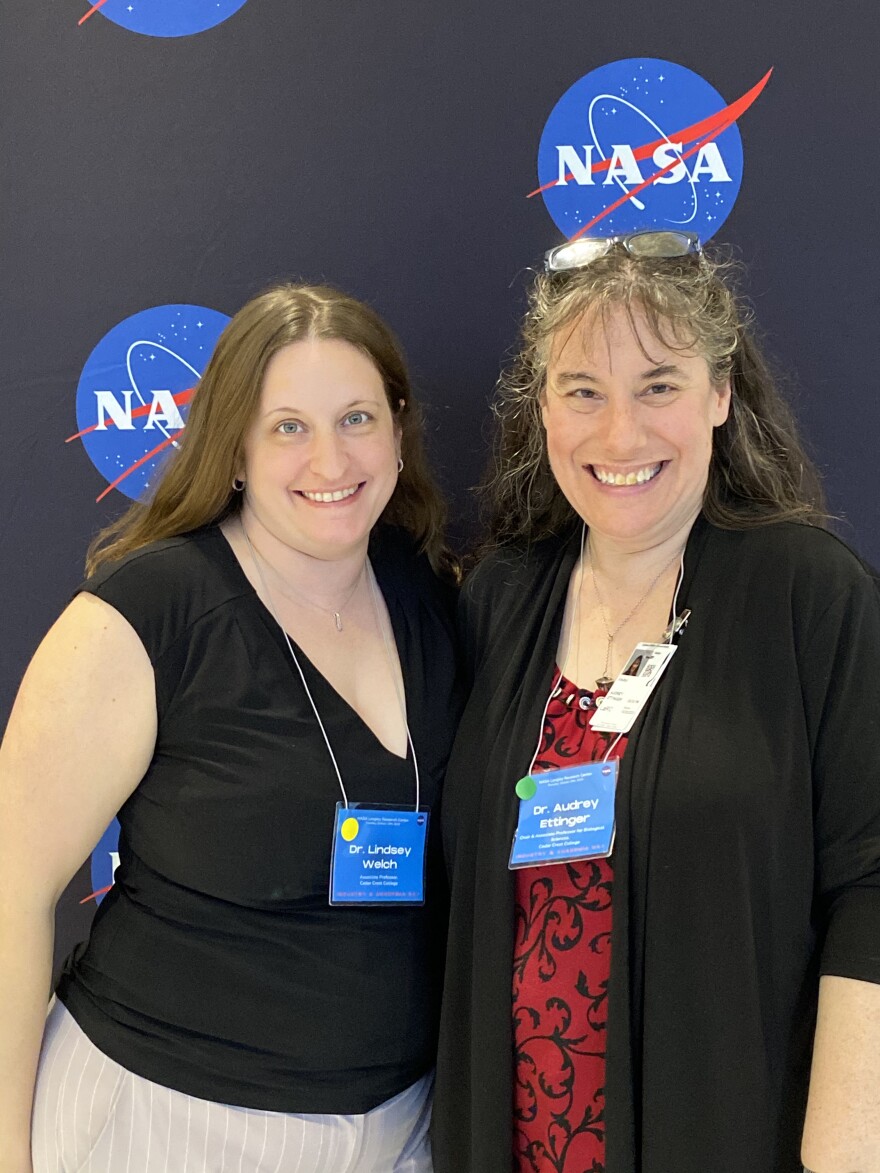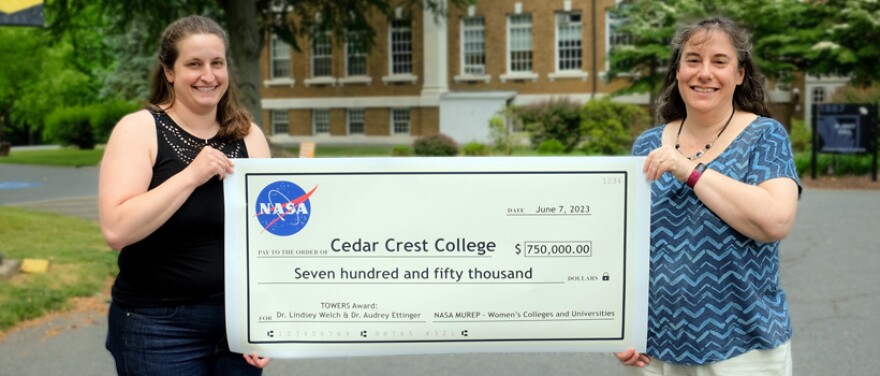ALLENTOWN, Pa. — There is absolutely no convincing data that women are any less equipped to be scientists — intellectually, practically or mentally, Audrey J. Ettinger said.
“However, there's a ton of data that shows that we are socialized from a very, very young age that math is for boys, engineering is for boys,” said Ettinger, associate professor of biology and chair of Cedar Crest College’s Department of Biological Sciences. “Girls are given dolls to play with. Boys are given blocks to play with. Boys are given video games.
“And there's this whole ongoing impact.”
Ettinger and Lindsey A. Welch, an associate professor of chemistry at Cedar Crest, are working to bridge the science gender gap. The pair were recently awarded a three-year, $750,000 grant from NASA to help engage and retain women in STEM, or science, technology, engineering and math, disciplines. The college was one of seven institutions to get funding.
The goal, the pair said, is to create a more inclusive and equitable environment for women through research, mentorship, as well as faculty and staff development to help increase confidence, bolstering those considering pursuing a career in STEM fields.
“Representation is a huge aspect of retaining women in STEM,” Welch said. “And so, in women's colleges and universities, we’ll often have more female mentors or role models compared to co-educational institutions.
"The number of science faculty that I had through my years of school I can count on one hand, so having female representation as scientists in your life is crucial and very important for retaining women."Lindsey A. Welch, an associate professor of chemistry at Cedar Crest College
“I tell the story frequently that I can say from my background, that the number of science faculty that I had through my years of school I can count on one hand, so having female representation as scientists in your life is crucial and very important for retaining women.”
Data: Women in STEM
About a quarter of all U.S. workers are employed in STEM jobs, according to the National Science Foundation, and that figure is growing.
“Between 2011 and 2021, the STEM workforce grew by 5.9 million, from 29 million to 34.9 million, representing a 20% increase,” according to the foundation’s report, “The STEM Workforce.” “STEM workers as a percentage of the total workforce also increased, from 21% in 2011 to 24% in 2021.”
And, while there are almost double the amount of men than women in STEM jobs, data shows the number of women in these jobs are increasing relatively quickly compared to men.
“Although fewer women than men work in STEM occupations, their share of the STEM workforce grew at a faster rate,” according to the foundation. “Between 2011 and 2021, the number of women in the STEM workforce increased 31%, from 9.4 million to 12.3 million.
“For men, 22.6 million were employed in STEM occupations in 2021, up 15% from the 19.7 million employed in 2011.”
The American Association of University Women’s website lists the reasons why, historically, women have been held back from or chosen not to pursue careers in math and science.
They include teachers and parents often underestimating young girls’ math abilities, math anxiety passed from teachers to students and a well-known male-dominated culture in the field.
“Because fewer women study and work in STEM, these fields tend to perpetuate inflexible, exclusionary, male-dominated cultures that are not supportive of or attractive to women and minorities,” according to the association. “Women are subjected to a greater frequency of harassment and gender-devaluing biases in some fields of study, such as engineering and computer science, on campus and professionally.”
'Studying what's working'
When working on the grant proposal this spring, Ettinger and Welch said they created a “wish list” of everything they could do to support women students interested in math or science and then “found a way to tie it into a coherent idea.”
“We have some research focus, we have some mentoring kinds of activities, and then we have some faculty and staff development,” Ettinger said, adding that the grant pays for the programs as part of research into retaining women in STEM. “From our perspective, that's really exciting because it's getting our students access to some stuff that they wouldn't have gotten to do otherwise.
“But then our real goal is to be studying what's working, basically what is helping to retain women in STEM.”

Starting next year, and for three years total, 12 students will be able to participate in a five-week summer program before their freshman year begins, working on research projects and receiving mentorship from faculty and upper-class students.
“They'll be working on several different projects in small groups with an upper-class student and a faculty member,” she said. “So that's the biggest part of the funding is for that.
“We'll be paying the students, we will be paying for their housing, we will be paying the mentors and for their housing and the faculty, of course.”
There’s also funding available for students to travel to other labs and still get paid.
“Our students are often first-generation college students, students of color, students with maybe fewer financial resources than a typical private school,” she said. “And we want them to have those opportunities.
“The college is committed to working toward finding ways to fund students to do what would be an unpaid internship that our students can't do. They can't afford to do that.”
The NASA award will also fund a peer mentoring program to be developed during the academic year, pairing students to talk over successful strategies to navigate STEM classes and coursework, Welch said. There will also be career panels scheduled.
“We certainly have a career planning office on campus which does great things for our students, but we're looking to have STEM-specific guidance for our students,” Welch said. “And so we're going to support that and then we also have funding to have professional development for our faculty to educate them on inclusive teaching practices, as well as educating them on the barriers that women face in the STEM fields.”
So many young women arrive at college with baggage, Ettinger said – anxious that their math or science skills aren’t up to par, seeing their struggles in these disciplines as failures and reasons to give up, and lacking confidence in their abilities.
This infusion of funding, and the programs it provides, aim to show students what they may perceive is not always actually true.
“It's not a skills gap. It's not an ability gap,” Ettinger said. “It's not a gap in potential and not a gap in ability to be scientists. It really is a gap in confidence.”
“It's really OK to fail, and these are subjects that you can get better at if you just work hard,” she continued. “You're not going to know everything and that's what we're here for — to fill in those pieces.”


